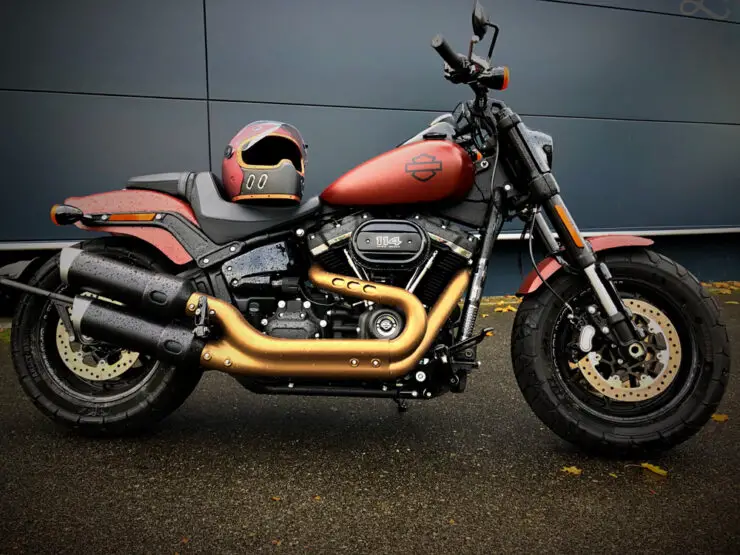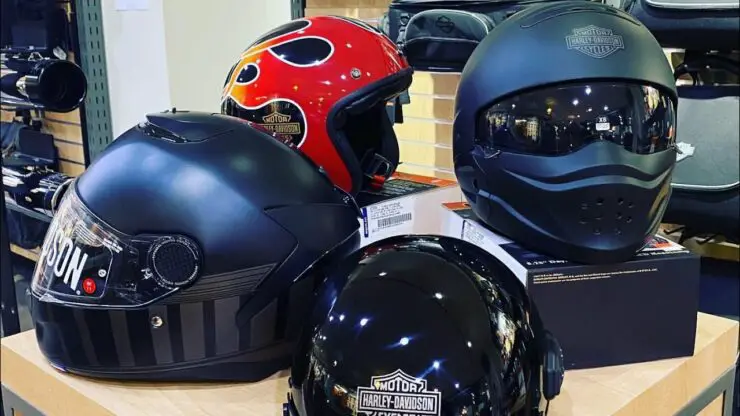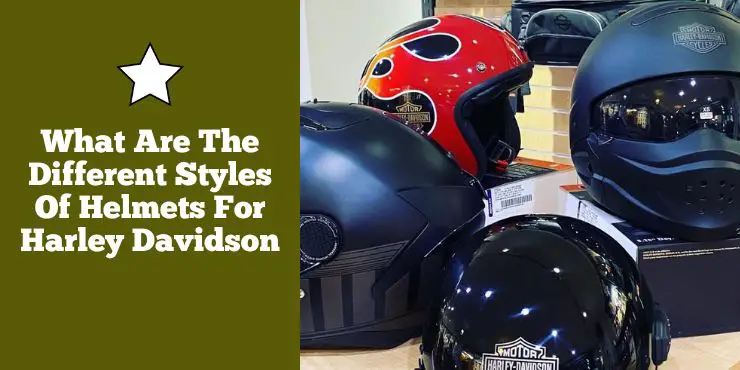Riding a Harley-Davidson is a unique experience like no other. But what is the one thing that makes it even better? The answer is helmets. Helmets not only make your ride safer but they can also give you a unique style that reflects your personality.
Harley-Davidson helmet styles include full-face, modular, open-face, and half-helmet. Each style provides a different balance between protection, visibility, and ventilation.
In this article, we will explore the different types of helmets available for Harley-Davidson riders. From classic leather to modern half-helmets, you will be sure to find the perfect helmet that will enhance your already amazing experience. So, let’s take a look at what are the different styles of helmets for Harley-Davidson and make your ride even more stylish.

What are the different styles of helmets for Harley-Davidson riders?
When it comes to the safety of a biker, wearing a helmet is paramount. However, not all helmets are created equal. Some of them offer more safety but lack style whereas others offer a more expressive feel but lack the safety quotient. There are different styles of helmets that offer different levels of protection and functionality.
>>> Click here to read our review of the Best Helmet For Harley-Davidson <<<
Understanding what are the different styles of helmets for Harley-Davidson riders and their features will help you make informed decisions when selecting the most suitable helmet for your needs. Here are the different styles of helmets, their features, their pros, their cons, and everything else in between that you must know about.
#1. Half Helmets
Half helmets or also known as shorty helmets or skull caps offer the minimum coverage required by safety standards. These helmets cover the top of the head but leave the face, neck, and ears exposed. They also offer a lightweight and minimalistic design, making them popular among bikers looking for a lightweight and minimalistic design, making them very popular among riders looking for a more open riding experience. However, they offer the least protection compared to other helmet types and might not be suitable for high-speed or long-distance rides.
Here are the key features of half helmets –
- Minimalist design – Half helmets come with a compact and lightweight design, covering just the top of the head
- Open face – The face, ears, and neck are exposed, which provides a more open riding experience for the biker
- Limited protection – While these helmets do meet the minimum safety requirements, they still offer the least protection compared to other helmet types
Here are the pros of using half helmets for Harley-Davidson riders –
- Freedom and openness – Half helmets offer a sense of freedom and an unobstructed view of the surroundings, which enhances the overall riding experience
- Lightweight – The minimalist design of half helmets makes them extremely lightweight and compact, which reduces the strain on the neck muscles during long rides
- Enhanced ventilation – The open design of these helmets allows for better airflow and ventilation, keeping the rider cool in warm weather
Here are the cons of using half helmets for Harley-Davidson riders –
- Limited level of protection – Half helmets offer the least amount of coverage, leaving the face, chin, and jaw exposed to potential injuries during accidents or collisions
- Minimal weather protection – Half helmets provide limited protection against adverse weather conditions, leaving riders exposed to rain, cold temperatures, and other environmental elements
- Reduced safety features – In comparison to other helmet types, half helmets typically lack advanced safety features such as impact-absorbing padding or built-in face shields
#2. Three-Quarter Helmets
Three-quarter helmets or open-face helmets cover the top, back, and sides of the head, leaving your face exposed. These helmets offer more protection than half helmets and they’re commonly used by Harley-Davidson riders who prefer a balance between protection and airflow. Three-quarter helmets typically come with a visor or a face shield that offers protection against wind and debris.
Here are the key features of three-quarter helmets –
- Head and side coverage – Three-quarter helmets cover the top, sides, and back of the head, offering more protection compared to half helmets
- Open face with visor – This type of helmet lacks a chin bar but often comes with a visor or face shield that provides some protection against wind and debris
- Enhanced airflow – Bikers can enjoy better ventilation and airflow compared to full-face helmets
Here are the pros of using three-quarter helmets for Harley-Davidson riders –
- More coverage than half helmets – Three-quarter helmets provide greater coverage than half helmets, offering increased protection for your head and sides
- Open-face experience – You’ll be able to enjoy the sensation of wind on your face while still maintaining a high level of head protection
- Improved ventilation – The lack of a chin bar allows for better airflow, offering enhanced ventilation compared to full-face helmets
Here are the cons of using three-quarter helmets for Harley-Davidson riders –
- Facial exposure – Although three-quarter helmets offer more coverage than half helmets, they’ll still leave your face and chin vulnerable to injuries in case of accidents
- Limited safety – Similar to half helmets, three-quarter helmets might lack some of the advanced safety features found in full-face helmets, compromising overall protection
- Noise and wind discomfort – The open-face design of these helmets allows for increased noise and wind turbulence, which could cause discomfort during rides, especially at higher speeds
#3. Full-face helmets
Full-face helmets offer the highest level of protection among different types of motorcycle helmets. They cover the entire head, including the face, chin, and jaw. These helmets offer a sturdy outer shell, an impact-absorbing inner liner, and a face shield that protects against wind, debris, and UV rays. Full-face helmets also offer superior protection in high-impact crashes and adverse weather conditions, making them perfect for bikers seeking maximum safety.
Here are the key features of full-face helmets –
- Complete head protection – These helmets cover your entire head, including the face, chin, and jaw
- Robust construction – Full-face helmets feature a sturdy outer shell, an impact-absorbing inner liner, and a built-in face shield or removable visor
- Superior protection – Full-face helmets offer the highest level of protection, reducing the risk of facial and head injuries during crashes
- Weather and noise resistance – The face shield offers a high level of protection against wind, rain, UV rays, and road debris while also reducing noise levels
Here are the pros of using full-face helmets for Harley-Davidson riders –
- Maximum head protection – Full-face helmets offer comprehensive coverage for the entire head, offering the highest level of protection
- Weather protection – These helmets shield riders from adverse weather conditions, including wind, rain, and cold temperatures
- Enhanced safety features – With features like built-in face shields, full-face helmets offer protection against wind, debris, and UV rays while also providing better noise reduction
Here are the cons of using full-face helmets for Harley-Davidson riders –
- Restricted field of view – The full-face coverage of these helmets could limit peripheral vision, requiring riders to turn their heads to compensate for reduced visibility
- Reduced ventilation – While many full-face helmets feature effective ventilation systems, others might provide limited airflow, which can lead to discomfort and increased heat buildup, especially in warmer weather conditions
- Longer removal process – Taking off a full-face helmet will require unfastening the chin strap and additional securing mechanisms, which can be slightly more time-consuming compared to other helmet types
#4. Modular helmets
Modular helmets or also known as flip-flop helmets combine different features of full-face and three-quarter helmets. They feature a hinged chin bar that can be flipped, allowing riders to have an open-face experience when needed. If the chin bar is locked in the downward position, modular helmets will provide the same protection as full-face helmets. This versatility makes them quite popular among bikers who value both protection and convenience.
Here are the key features of modular helmets –
- Versatility – Modular helmets come with a hinged chin bar that can be flipped up, allowing riders to switch between an open-face and full-face configuration
- Convenient design – The flip-up mechanism offers more convenience when interacting with others or for improved ventilation during stops
- Similar level of protection as full-face helmets – When the chin bar is locked in the downward position, modular helmets offer the same level of protection as full-face helmets
Here are the pros of using modular helmets for Harley-Davidson riders –
- Convenience – These helmets offer the convenience and versatility of a flip-up chin bar, allowing riders to switch between full-face and open-face configurations when needed
- Improved visibility – Once the chin bar is lifted, riders will be able to enjoy an unobstructed view, enhancing peripheral vision and situational awareness
- Adaptability – The flip-up design will allow you to eat, drink, or communicate without having to fully remove the helmet
Here are the cons of using modular helmets for Harley-Davidson riders –
- Increased weight and bulkiness – Modular helmets tend to have comparatively heavier and bulkier due to the flip-up chin bar mechanism, which can often cause neck strain during long rides
- Potential mechanism failure – The hinge mechanism of modular helmets presents the prospect of potential failure, and if not properly maintained and used, it can compromise the overall safety and integrity of the helmet
- Noise and wind discomfort – The flip-up design of modular helmets might result in increased wind noise and turbulence, impacting rider comfort, especially at high speeds
#5. Open-face helmets
Open-face helmets are similar to three-quarter helmets in the sense they cover the top, back, and sides of the head but lack a face shield or chin bar. They offer an open riding experience and offer good ventilation. These helmets are favored by bikers who prefer a sense of freedom and better visibility. However, they offer less protection to the face and chin, making them less suitable for high-speed riding or adverse weather conditions.
Here are the key features of open-face helmets –
- Head and side coverage – Open-face helmets cover the top, back, and sides of the head similar to three-quarter helmets
- Open riding experience – These helmets lack a chin bar or face shield, which provides an open riding experience and better visibility
- Ventilation and comfort – Open-face helmets offer great ventilation, which makes them suited for warm-weather riding
- Limited protection – Such helmets offer less protection to the face and chin compared to full-face or three-quarter helmets
Here are the pros of using open-face helmets for Harley-Davidson riders –
- Open-face experience – Open-face helmets offer an unobstructed view of the face and a greater sense of freedom during long rides
- Comfort and airflow – With no chin bar, these helmets allow for increased airflow and ventilation, keeping riders cool in warm weather
- Communication and interaction – Open-face helmets facilitate easier communication with other riders or pedestrians as facial expressions and verbal communication are possible
Here are the cons of using open-face helmets for Harley-Davidson riders –
- Limited protection – Open-face helmets leave your face and chin exposed to injuries in the event of accidents, making them less secure than full-face helmets
- Reduced weather and debris protection – These helmets offer minimal protection against adverse weather conditions, wind, debris, and insects, which can impact rider comfort and safety
- Reduced noise reduction – The open design of open-face helmets allows for increased wind noise, which makes communication and concentration more challenging during long rides
Safety standards for Harley-Davidson helmets
When it comes to motorcycle safety, choosing a helmet that meets rigorous safety standards will be paramount. Harley-Davidson is a renowned brand in the motorcycle industry and it offers helmets that comply with different safety certifications. Here are the different safety standards that have been set for motorcycle helmets manufactured by brands like Harley-Davidson. Understanding these safety standards will help Harley-Davidson bikers make well-informed decisions and prioritize their well-being on the road.
DOT Certification
The DOT (Department of Transport) certification is the minimum safety standard required for motorcycle helmets in the United States. These safety standards signify that a helmet meets the safety requirements set forth by the Department of Transportation. Some of the key features of DOT-certified helmets include impact protection, penetration resistance, field of vision, and more.
Motorcycle helmets must offer adequate impact absorption to reduce the risk of head injuries during crashes. DOT-certified helmets undergo tests to ensure that these helmets can withstand penetration from sharp objects, such as rocks or debris.
Helmets should also have a secure chin strap or retention system to keep them firmly in place during an accident. DOT-certified helmets ensure an adequate field of vision, allowing bikers to see their surroundings clearly.
Snell certification
Snell certification is an independent voluntary safety standard developed by the Snell Memorial Foundation. Snell sets higher safety standards compared to DOT certification and is commonly recognized by racing organizations and enthusiasts. Some of the key features of Snell certifications include rigorous testing, multiple impact protection, quality control, and more.
Harley-Davidson helmets undergo testing for impact absorption, retention system strength, and penetration resistance. Snell-certified helmets are designed to offer protection against multiple impacts, enhancing rider safety in case of successive crashes. Further, these helmets should also undergo regular quality control inspections to maintain the standard of safety.
ECE certification
ECE (Economic Commission for Europe) certification is a safety standard recognized by more than 50 countries, including many European nations. Helmets with ECE certification meet the safety standards that have been established by the Economic Commission for Europe. The key features of ECE-certified helmets include extensive testing, a dynamic retention system, reflective properties, and more.
Helmets undergo different tests for impact protection, retention system strength, field of vision, and resistance to penetration. ECE-certified helmets need a robust and reliable chin strap or retention system. Helmets should have reflective properties to enhance visibility in low-light conditions.
SHARP rating system
The SHARP rating system (Safety Helmet Assessment and Rating Programme) is a British initiative that offers independent safety ratings for motorcycle helmets. It assesses helmets on a scale of one to five stars based on their performance in impact testing. Some of the key features of the SHARP rating system include impact testing, transparency, continuous evaluation, and more.
Helmets undergo rigorous impact tests at different velocities and angles to determine their performance during crashes. The SHARP rating system provides detailed info on how helmets perform in different impact scenarios. The rating system is regularly updated as new helmets are tested, enabling riders to make informed choices based on the latest safety data.

Important factors to consider for choosing the right helmet for Harley-Davidson riders
If you are a Harley-Davidson rider, safety on the road must be a top priority. An important aspect of motorcycle safety will involve selecting the right helmet. With so many options available, it’ll be important to consider all the factors to determine whether you’re choosing a helmet that offers optimal protection, comfort, and style. Here are the important factors to consider when choosing the right helmet for Harley-Davidson riders –
#1. Safety standards and certifications
Make sure that the helmet meets recognized safety standards such as DOT, Snell, ECE, or other certifications specific to your region. These standards ensure that the helmet has undergone rigorous testing to provide adequate protection in the event of an accident.
#2. Fit and comfort
A well-fitting helmet will be important for both safety and comfort. You need to measure your head’s circumference and try on different helmets that match your size. Moreover, consider the helmet’s shape to ensure it fits your head shape comfortably.
Look for helmets with comfortable padding that snugly conform to your head. The interior lining must be breathable, moisture-wicking, and removable for easy cleaning. Moreover, check for a secure chin strap or retention system that keeps the helmet in place during rides.
#3. Type of helmet
You must consider the type of helmet that suits your riding style and preferences. There are different types of helmets like full-face, half, three-quarter, modular, and more.
Full-face helmets offer maximum coverage, protection, and better aerodynamics. They are ideal for long rides, touring, or high-speed riding. Half-helmets offer minimal coverage, freedom, and airflow. These are suitable for short rides or bikers who prefer a more open riding experience. Modular helmets combine the features of open-face and full-face helmets, offering versatility with a flip-up chin bar. They are great for bikers who want the option of full-face protection or open-face convenience.
#4. Ventilation
Proper ventilation is important to keep you cool and comfortable during rides. Look for helmets having adequate vents that allow for airflow without compromising safety. Ventilation systems need to effectively channel air through the helmet to reduce heat buildup.
#5. Visor and shield
You should also consider the visor or shield options based on your riding needs. Opt for helmets that have easily adjustable and scratch-resistant face shields that offer protection against wind, debris, and UV rays. Consider helmets that have anti-fog or tinted visors for enhanced visibility in different weather conditions. If you wear prescription glasses or use a Bluetooth connection system, make sure that the helmet accommodates them comfortably.
#6. Style and design
Harley-Davidson riders often value style and personal expression. Choose a motorcycle helmet that reflects your unique aesthetic preferences, considering colors, designs, and graphics that align with your bike.
#7. Budget
Establish a budget range for your helmet purchase. While quality and safety must be prioritized, you can easily find helmets in different price ranges to suit your needs. You should remember that investing in a high-quality helmet is an investment in your safety.

Benefits of wearing a helmet for Harley-Davidson riders
As a Harley-Davidson biker, the exhilaration of the open road is an experience unlike any other. However, it is important that you prioritize safety, and one of the accessories that will help you with that is a helmet. There are a number of benefits that come with wearing a helmet when riding a Harley-Davidson bike. Here are the benefits of wearing a helmet for Harley-Davidson riders, highlighting the importance of head protection and the impact it has on your riding experience.
#1. Enhanced head protection
Wearing a helmet offers essential protection for your head, safeguarding you from severe injuries in the event of an accident or collision. The helmet acts as a barrier, absorbing and dispersing the impact energy, reducing the risk of traumatic brain injuries, skull fractures, or other life-threatening head injuries.
#2. Reduced risk of fatalities and serious injuries
Studies have shown that wearing a helmet significantly reduces the risk of fatalities and severe head injuries in motorcycle accidents. A helmet acts as a crucial line of defense, helping to mitigate the impact forces and protect your head from direct contact with the road, obstacles, or other vehicles.
#3. Protection against external elements
Motorcycle helmets provide a shield against external environmental elements, ensuring a more comfortable and focused riding experience. Helmets protect your eyes and face from windblown debris, dust, insects, or small rocks that could cause distractions or injuries during rides. Helmets with visors or face shields will protect you from rain, hail, and harsh weather conditions, enhancing visibility and preventing discomfort.
#4. Enhanced visibility and providing eye protection
Many helmets come equipped with face shields or visors that offer clear visibility and eye protection. Tinted visors reduce glare from the sun, improving visibility and minimizing eye strain, especially during daytime rides. Helmets having built-in sun visors offer additional protection against harmful UV rays, safeguarding your eyes from long-term damage.
#5. Noise reduction
Motorcycle rides, especially on a Harley-Davidson bike, can be noisy and prolonged exposure to high noise levels. This can easily result in hearing damage. Wearing a helmet reduces wind noise while providing a quieter and more enjoyable ride. It will allow you to better hear important sounds such as traffic signals, sirens, or other vehicles, improving your overall awareness on the road.
#6. Provides confidence and focus
Wearing a motorcycle helmet will give you the peace of mind and confidence to fully enjoy your ride. By knowing that you are protected, you’ll be able to focus on the road ahead, taking in the sights and sounds, and immersing yourself in the Harley-Davidson experience.
#7. Compliance with legal requirements
Wearing a helmet is not only a matter of personal safety but it is also a legal requirement in many jurisdictions. By wearing a helmet, you will not only protect yourself but you’ll also adhere to traffic laws and avoid potential fines and penalties.
FAQ
What are the different styles of helmets available for Harley Davidson?
There are several styles of helmets available for Harley Davidson riders, including full-face, half-face, open-face, 3/4, modular, and novelty helmets. Each style offers different levels of coverage, protection, and comfort, so it’s important to consider which style is best for your needs.
What are the advantages and disadvantages of each type of helmet?
Full-face helmets offer the most coverage and protection, but can be hot and bulky. Half-face helmets provide less coverage, but allow for better ventilation and visibility. Open-face helmets provide the least coverage but provide a more open and unrestricted feel. 3/4 helmets are a hybrid of full-face and open-face helmets, providing some coverage and protection with a more open feel. Modular helmets offer the convenience of a flip-up visor for easy access to the face, but can be heavier and more expensive. Novelty helmets are designed for show and often lack the safety features of other styles.
What should I consider when choosing a helmet for my Harley Davidson?
When choosing a helmet for your Harley Davidson, you should consider the style of riding, your preference for coverage and protection, ventilation needs
>>> Read more about Helmets for Harley-Davidson Riders <<<

